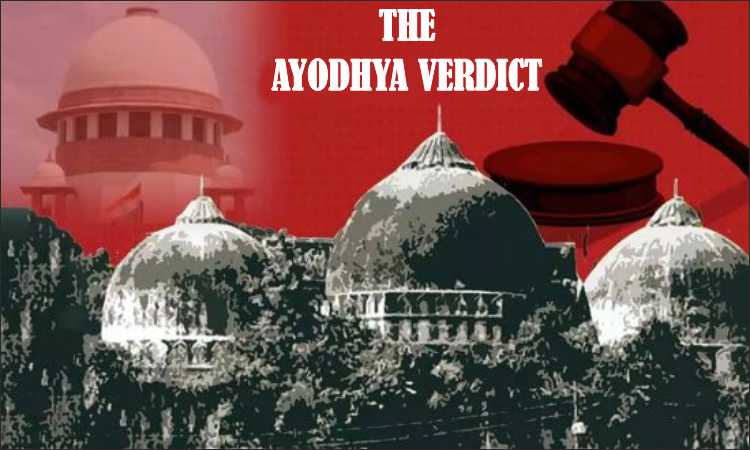M Siddiq (D) Thr Lrs
v.
Mahant Suresh Das & Ors.
Facts & Issues -
Hon’ble Supreme Court on November 9th, 2019 gave its verdict on the case involving the longest running dispute in the history of India and its judicial system, owing its importance to history, politics, communal riots and most importantly religion. Therefore the facts of the case which was an appeal before the SC against the Allahabad HC verdict of 2010 need to be explained through a timeline of events which is as follows:
- The issue of the case revolves around the possession of a site which happens to be religiously important for Hindus as it is considered by them to be the birthplace of Lord Ram. At this site in 1528 Babri Masjid was built by Mir Baqi, the commander of the Mughal emperor Babur. as per the local traditions the mosque was built after demolishing a temple which was built at the spot which is believed to be the spot where Lord Ram was born.
- Later in 1949 the Ram Lalla idols were put under central dome outside the disputed area.
- In 1950 a suit was filed in the Faizabad District court by Gopal Simla Visharad claiming rights to worship Ram Lalla idols.
- Nirmohi Akhara in 1959 filed a suit for the possession of the site.
- Two years later in 1961 from the Muslim side, the UP (Uttar Pradesh) Sunni Central Waqf Board filed a similar suit regarding possession of the site.
- On Feb 1, 1986 the local court ordered the govt. to open the site for Hindu worshippers. However a Babri Mosque Action committee was formed by the Muslims to protest this order allowing the Hindus to worship.
- The Vishwa Hindu Parishad in 1989 laid the foundations of a temple adjacent to the disputed structure.
- From 1990-1992 the events including rallies, movements, innocent killings, formation of the Ram Janmbhoomi Nyas trust for the purpose of handling the land of 2.77 acres of land acquired by the state govt. for tourism purposes, hearing of the legality of the foundation of the disputed structure by Allahabad HC ultimately led to the demolition of Babri Mosque on December 6, 1992.
- Following the demolition many communal riots happened in India including Godhra killings in Gujarat in 2002 followed by riots and more killings.
- According to a survey ordered by the court in 2003, a temple existed under the mosque at the site, which was again denied by Muslims.
- In 2007 a review filed on the dispute was refused by the SC
- On 30th September, 2010 in response to four suits filed, the Allahabad HC gave its verdict dividing the site between three parties namely the deity Ram Lalla represented by Hindu Maha Sabha to get the central shrine where the idol is placed, the Nirmohi Akhada to get the peripheral structures including Sita Rasoi and Ram Chabutra and the Sunni Waqf Board having the rest; thus having a share of 1/3rd each (Justices S U Khan and Sudhir Agarwal). The same year in December itself this verdict by the Allahabad HC was challenged by the Akhil Bhartiya Hindu Mahasabha and the Sunni Waqf Board and they moved to the SC.
- In 2011 SC put a stay on Allahabad HC’s order and maintained status quo.
- In 2017 an out of court settlement was suggested by CJI JS Kehar. However in December 2017 Allahabad HC’s verdict was challenged by thirty two civil rights activists.
- In Jan 2018 a five judge constitution bench was formed which was reconstituted in the same month. The reconstituted and final bench was headed by CJI Ranjan Gogoi and other judges being SA Bobde, Ashok Bhushan, S A Nazeer and D Y Chandrachud.
- The final hearing by SC was held from 6th Aug 2019- 16th Oct, 2019. Thus the final hearing concluded on 9th November, 2019 in which the SC ordered the 2.77 acres of the disputed site to be handed to a trust to build the temple and an alternate land of 5 acres to be handed to the Sunni Waqf board for building a mosque.
The Central government has been ordered to formulate a scheme within three months to implement the order.
The three parties involved were:
- The Nirmohi Akhara (represented by Sushil Kumar)- claiming the possession of the inner courtyard
- The UP Central Sunni Waqf Board (represented by Rajeev Dhavan) - claimed the possession of the inner courtyard and insisted on the reconstruction of the mosque. It claimed that placing Ram idols in 1949 was illegal.
- The Ram Lalla Virajmann (represented by CS Vidyanath)- claimed that existence of temple underlying the structure and that the area has been under its control since 1949. It supported its claim on the basis of the reports and findings made by the ASI (Archaeological Survey of India).
You can also read the Blog by visiting [Blog]
For more information, visit [Aashayein Enquiry Section]
Decision -
The present judgement is compiled within 1045 pages. The five judge bench headed by CJI Ranjan Gogoi gave a unanimous judgment which can be briefly explained with the help of following highlights:
Hon’ble SC directed Ram Lalla, the deity to be the rightful owner of the entire disputed land , while ordering a separate land of 5 acres to be given to the Muslim side for the purpose of building a mosque (in pursuance of the powers vested in the court under Article 142 of the Indian Constitution which gives power to Supreme Court to pass such decree or make such order as is necessary for doing complete justice) which has been considered as a compensation or restitution to the unlawful demolition of the Babri Masjid in 1992. Such land shall be allotted either by the

